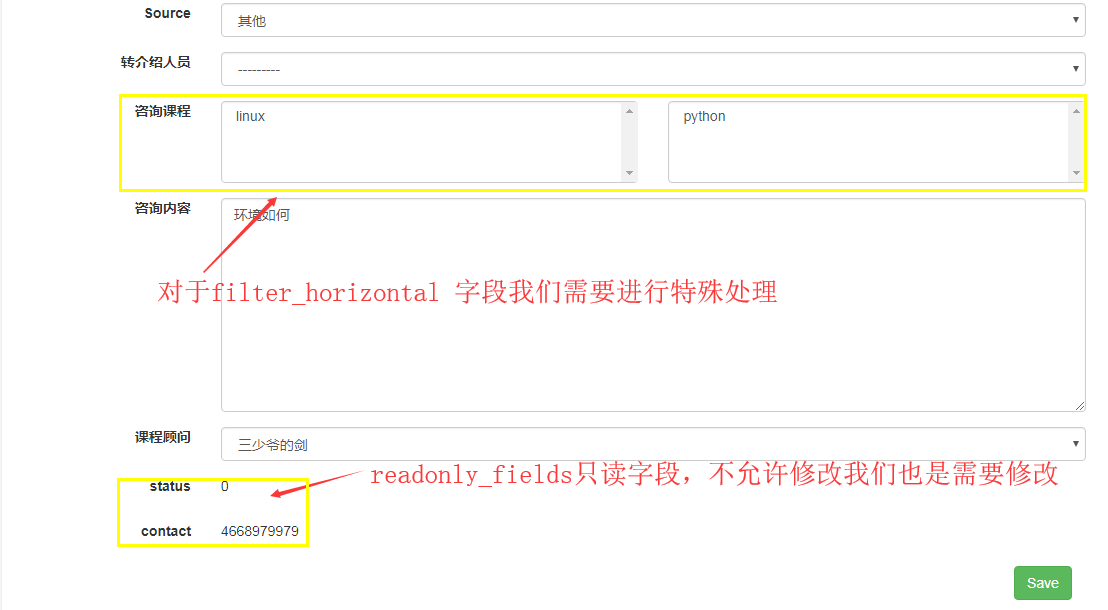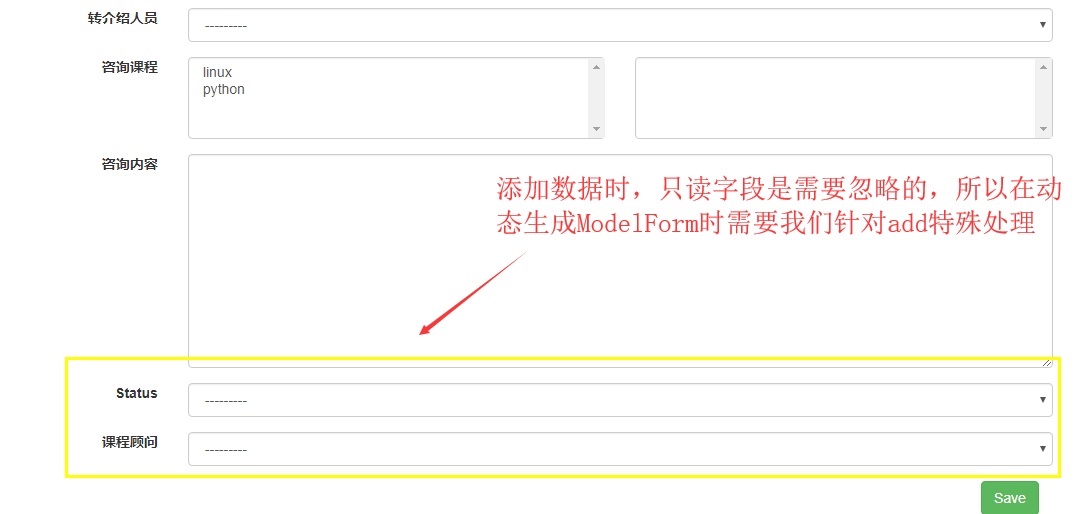Day1:项目分析
一:需求分析

二:CRM角色功能介绍

三:业务场景分析
销售: 1.销售A 从百度推广获取了一个客户,录入了CRM系统,咨询了Python课程,但是没有报名 2.销售B 从qq群获取一个客户,成功使他报名Python班,然后给他发送了报名连接,等待用户填写完毕后,将他添加到Python具体的学习班级中 3.销售C 打电话给之前的一个客户,说服他报名Python课程,但是没有成功,更新了跟踪记录 4.销售D 获取了一个客户,录入信息时,发现此客户已经存在,不允许重复录入,随后通知相应的原负责人跟进 5.销售E 从客户库中获取了,超过一个月未跟进的客户,进行再次跟进 6.销售主管 查看了部门本月的销售报表,包括来源分析,成单率分析,班级报名数量分析,销售额环比,同比
学员: 1.客户A 填写了销售发来的报名连接,上传了个人的证件信息,提交,之后收到邮件,告知报名成功,并为他开通了学员账号,升级为学员A 2.学员A 登录学员系统,看到自己的合同,报名的班级,课程大纲 3.学员A 提交了Python课程当时课时作业 4.学员A 查看自己的Python课程成绩,排名 5.学员A 搜索问题,未找到答案,录入一条问题 6.学员A 转介绍学员,录入其信息
讲师: 1.讲师A 登录CRM系统,查看自己管理的班级列表 2.讲师A 进入Python 5期课程,创建第3节的上课记录,填写了本节课内容,作业要求 3.讲师A 在课程中点名,对点名情况进行录入,标记相关状态 4.讲师A 批量下载所有学员的课时作业,给每个学员在线批注了成绩+状态
管理员: 1.创建课程 C++,Python.. 2.创建校区 上海,北京.. 3.创建班级 C++35期,Python27期 4.创建账号 ABCD 5.创建了销售,讲师,学员角色 6.为账号分配到对应的角色,将ABCD分配给销售 7.创建相关权限 8.为销售角色分配了相关权限
四:表结构设计
数据库关联模型
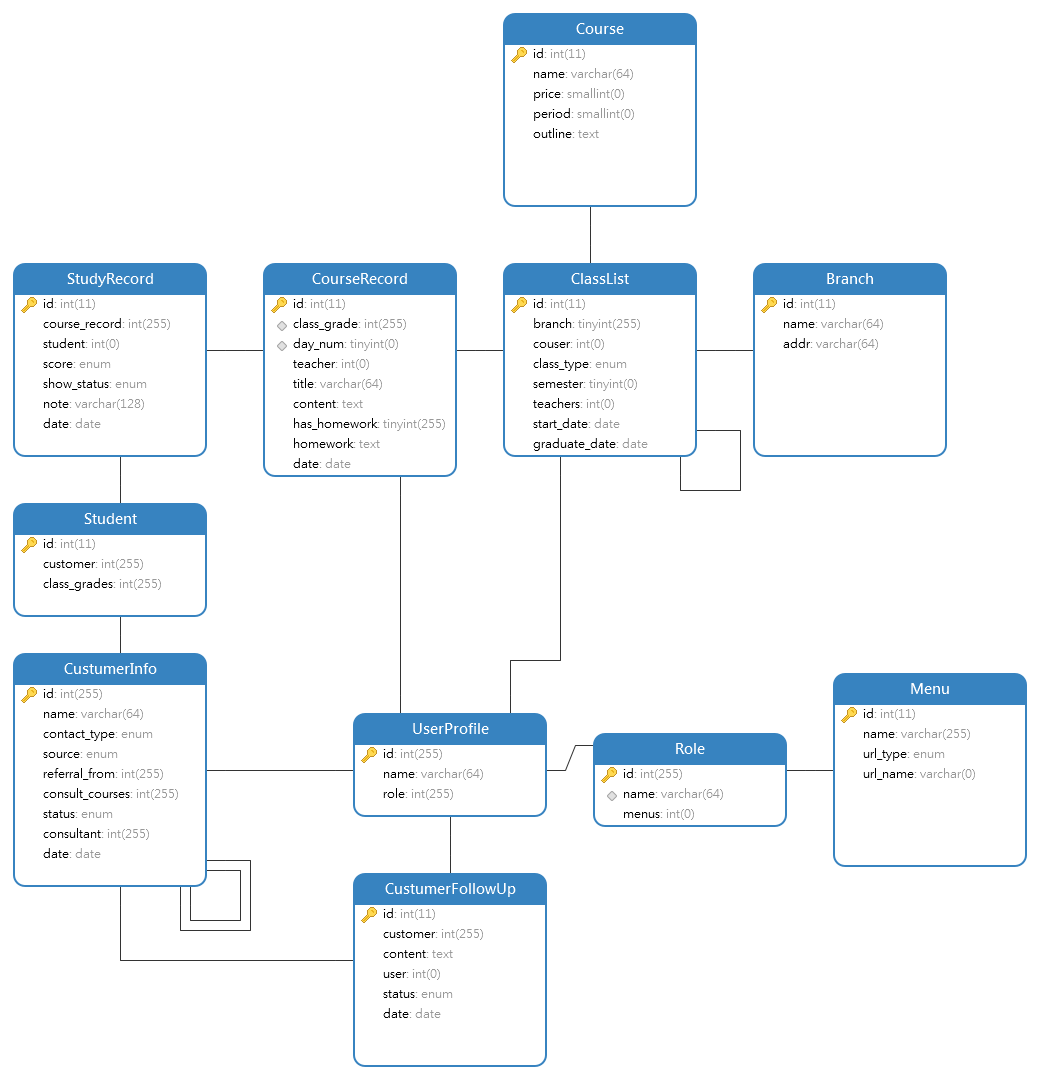
Django表结构实现

from django.db import models from django.contrib.auth.models import User # Create your models here. class UserProfile(models.Model): ''' 用户信息表: 含有讲师,销售,管理员这些正式人员 ''' user = models.OneToOneField(User) #使用的是Django自带的用户验证Username, password and email are required. Other fields are optional. name = models.CharField(max_length=64,verbose_name="姓名") role = models.ManyToManyField("Role",blank=True) #,null=Truenull has no effect on ManyToManyField.,null对于manytomanyfield无作用,会报警 def __str__(self): return self.name class Role(models.Model): ''' 角色表:学员,讲师,销售,管理员 ''' name = models.CharField(max_length=64,unique=True) menus = models.ManyToManyField("Menu",blank=True) def __str__(self): return self.name class Menu(models.Model): ''' 动态菜单 ''' name = models.CharField("菜单名",max_length=64) url_type_choices = ( (0,"absolute"), #绝对路径/Sale/index.html (1,"dynamic"), #动态url,根据url()方法中的name获取 ) url_type = models.SmallIntegerField(choices=url_type_choices) url_name = models.CharField("URL",max_length=128) def __str__(self): return self.name class CustumerInfo(models.Model): ''' 客户信息表:联系方式,姓名等 ''' name = models.CharField(max_length=64,null=True,blank=True) #开始咨询的时候允许为空 contact_type_choices = ((0,'qq'),(1,"微信"),(2,'手机')) contact_type = models.SmallIntegerField(choices=contact_type_choices,default=0) contact = models.CharField(max_length=64,unique=True) source_choices = ( (0,'QQ群'), (1,"51CTO"), (2,"百度推广"), (3,"知乎"), (4,"转介绍"), (5,"其他") ) source = models.SmallIntegerField(choices=source_choices) referral_from = models.ForeignKey("self",blank=True,null=True,verbose_name="转介绍人员") consult_courses = models.ManyToManyField("Course",verbose_name="咨询课程") #咨询的课程,允许咨询多门 consult_content = models.TextField("咨询内容",blank=True) status_choices = ((0,"未报名"),(1,"已报名"),(2,"已退学")) status = models.SmallIntegerField(choices=status_choices) consultant = models.ForeignKey("UserProfile",verbose_name="课程顾问") date = models.DateField(auto_now_add=True) def __str__(self): return self.name class CustumerFollowUp(models.Model): ''' 客户跟踪记录表:跟踪进度 ''' customer = models.ForeignKey("CustumerInfo") content = models.TextField(verbose_name="跟进内容") user = models.ForeignKey("UserProfile",verbose_name="跟进人员") status_choices = ( (0,"近期无报名计划"), (1,"一个月内报名"), (2,"2周内报名"), (3,"已报名"), ) status = models.SmallIntegerField(choices=status_choices) date = models.DateField(auto_now_add=True) def __str__(self): return self.content class Student(models.Model): ''' 学员信息表:(未报名的客户在客户表中),报名成功的在学员表 ''' customer = models.ForeignKey("CustumerInfo") class_grades = models.ManyToManyField("ClassList") #学员可以报多门课程 def __str__(self): return self.customer.name class Course(models.Model): ''' 课程表 ''' name = models.CharField(max_length=64,verbose_name="课程名称",unique=True) price = models.PositiveSmallIntegerField() #必须为正 period = models.PositiveSmallIntegerField(verbose_name="课程周期(月)",default=5) outline = models.TextField(verbose_name="大纲") def __str__(self): return self.name class ClassList(models.Model): ''' 班级列表 ''' branch = models.ForeignKey("Branch") #校区关联 couser = models.ForeignKey("Course") class_type_choices = ( (0,"脱产"), (1,"周末"), (2,"网络班") ) class_type = models.SmallIntegerField(choices=class_type_choices,default=0) semester = models.SmallIntegerField(verbose_name="学期") teachers = models.ManyToManyField("UserProfile",verbose_name="讲师") start_date = models.DateField("开班日期") graduate_date = models.DateField("毕业日期",blank=True,null=True) def __str__(self): return "%s (%s)期"%(self.couser,self.semester) class Meta: unique_together = ('branch','class_type',"couser","semester") #联合唯一 class CourseRecord(models.Model): ''' 上课记录:该节课程内容等 ''' class_grade = models.ForeignKey("ClassList",verbose_name="上课班级") day_num = models.PositiveSmallIntegerField(verbose_name="课程节次") teacher = models.ForeignKey("UserProfile") title = models.CharField("本节主题",max_length=64) content = models.TextField("本节内容") has_homework = models.BooleanField("本节是否有作业",default=True) homework = models.TextField("作业需求",blank=True,null=True) date = models.DateTimeField(auto_now_add=True,verbose_name="上课时间") def __str__(self): return "%s第(%s)节"%(self.class_grade,self.day_num ) class Meta: unique_together = ("class_grade","day_num") class StudyRecord(models.Model): ''' 学习记录表:学员考勤,作业,成绩,备注 ''' course_record = models.ForeignKey("CourseRecord") student = models.ForeignKey("Student") score_choices = ( (100,"A+"), (90,"A"), (85,"B+"), (80,"B"), (75,"B-"), (70,"C+"), (60,"C"), (40,"C-"), (0,"N/A"), #不可得not avaliable (-50, "D"), #未交作业 (-100,"COPY") #抄袭 ) score = models.SmallIntegerField(choices=score_choices) show_choices = ( (0,"缺勤"), (1,"已签到"), (2,"迟到"), (3,"早退"), ) show_status = models.SmallIntegerField(choices=show_choices) note = models.CharField("情况备注",max_length=128,blank=True,null=True) date = models.DateTimeField(auto_now_add=True) def __str__(self): return "%s %s %s"%(self.course_record,self.student,self.score) class Branch(models.Model): ''' 校区 ''' name = models.CharField(max_length=64,unique=True) addr = models.CharField(max_length=128,blank=True,null=True) def __str__(self): return self.name
Day2:主要实现功能kingadmin为各个应用实现一个类似于Django自带的数据库管理功能
kingadmin目录

销售目录
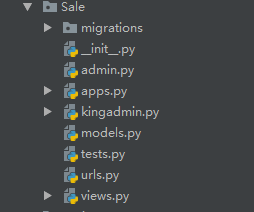
学员目录
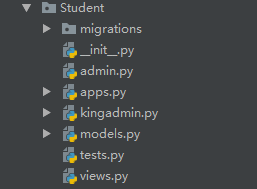
1.首先我们需要在项目启动后(进入Kingadmin模块中view视图后,能够自动采集所有的应用中需要我们采集的数据库信息)
(1)先设置采集方法:在每个需要我们采集的应用模块中添加上kingadmin.py文件(类似于后台admin会在应用模块的admin.py中采集信息一样)。如上面目录结构,在其中添加了kingadmin.py

from kingadmin.sites import site #虽然说,每个APP:sale,student都去导入了一次site,但是在python项目中对于同一个模块只会导入一次,所以这本身就是单例模式(使用的是内存中存在的那个) from kingadmin.admin_base import BaseKingAdmin from repository import models print("Sale.kingadmin") class CustomerAdmin(BaseKingAdmin): list_display = ['name','contact_type','contact','source','consult_content','consultant','status','date'] list_filter = ['source','consultant','status','date'] search_fields = ['contact','consultant__name'] site.register(models.CustumerInfo,CustomerAdmin) site.register(models.Role) site.register(models.Menu) site.register(models.UserProfile)

from kingadmin.sites import site from kingadmin.admin_base import BaseKingAdmin from Student import models class TestAdmin(BaseKingAdmin): list_display = ['name'] site.register(models.TestAdmin,TestAdmin) ---------------------------------------------------------- student模块中自定义一个表 class TestAdmin(models.Model): name = models.CharField("姓名",max_length=64) def __str__(self): return self.name
从中发现需要用到一个基类BaseKingAdmin来自于kingadmin模块:是为了防止注册事件时出现为空的现象,而且在基类中添加功能更加方便

class BaseKingAdmin(object): pass
还需要from kingadmin.sites import site,使用到site方法(类似于admin.site.register(模型,自定义模型显示类)):功能是将各个模块中的数据模型统一添加在一个数据结构中,方便调用

from kingadmin.admin_base import BaseKingAdmin class AdminSite(object): def __init__(self): self.enabled_admins = {} def register(self,model_class,admin_class=None): ''' 注册admin表 :param model_class: :param admin_class: :return: ''' app_name = model_class._meta.app_label #app_label是当前应用的名字 一个应用可以注册多个表 model_name = model_class._meta.model_name #model_name是表名 和app_lable连接就是数据表全名 if not admin_class: admin_class = BaseKingAdmin() else: admin_class = admin_class() if app_name not in self.enabled_admins: self.enabled_admins[app_name] = {} admin_class.model = model_class self.enabled_admins[app_name][model_name] = admin_class site = AdminSite()
将数据统一放入self.enabled_admins{}中,形式为self.enabled_admins[模块][表名] = 自定义模型显示类(默认BaseKingAdmin)
注意:虽然在每个模块中都导入了一次sites模块,使用一次site对象,实际上使用的是同一个site对象
可以使用id(site)查看内存,因为python机制中将一个模块导入后,会将其保存在内存中,下次导入数据的时候,会直接从内存中获取数据(所以大家使用的是一个site对象)
所以说:python模块本身就是单例模式
(2)从settings.py中获取各个模块。创建app_setup.py文件,在项目进入view时去调用该文件,并执行,获取到所有模块的信息
进入views.py自动调用app_setup.kingadmin_auto_discover()方法

from django.shortcuts import render,redirect from django.contrib.auth import authenticate,login,logout #快捷操作 from kingadmin import app_setup app_setup.kingadmin_auto_discover() #用来导入所有含Kingadmin的模块,模块中会去调用相应的Kingadmin文件去注册事件 from kingadmin.sites import site #发现只导入模块一次,site对象只有一个 ---------------------下面实现的是将数据分发给前端------------------------------------- def get_filter_result(request,querysets): filter_conditions = {} for k,v in request.GET.items(): if v: filter_conditions[k] = v return querysets.filter(**filter_conditions),filter_conditions def table_obj_list(request,app_name,model_name): '''取出指定的数据返给前端''' admin_class = site.enabled_admins[app_name][model_name] model_class = admin_class.model querysets = model_class.objects.all() filter_data,filter_conditions = get_filter_result(request,querysets) print(filter_conditions) admin_class.filter_conditions = filter_conditions #也可以传值给前端,但是这样也不错 return render(request,"kingadmin/table_obj_list.html",{"queryset":filter_data,'admin_class':admin_class})
看如何采集各个模块信息:从配置文件中settings的INSTALLED_APPS中获取所有模块信息

INSTALLED_APPS = [ 'django.contrib.admin', 'django.contrib.auth', 'django.contrib.contenttypes', 'django.contrib.sessions', 'django.contrib.messages', 'django.contrib.staticfiles', 'repository.apps.RepositoryConfig', 'kingadmin', 'Student', 'Sale', ]
views调用了app_setup中的kingadmin_auto_discover()方法自动采集信息,下面看看app_setup文件:实现方法。反向查找
from django import conf #实现动态获取配置文件,而不是以目录形式 import importlib def kingadmin_auto_discover(): for module in conf.settings.INSTALLED_APPS: try: # md = importlib.import_module('.kingadmin',module) #这个也可以 md = __import__('%s.kingadmin'%module) #导入Kingadmin,然后回去执行该文件中的数据,去注册事件(模块导入后,会自动使用site.register方法注册事件) except ImportError as e: pass
(3)上面将数据采集完毕,方法内存中site对象中,使用app_index视图方法,可以实现后台管理admin首页功能
def app_index(request):return render(request,"kingadmin/app_index.html",{'site':site})

<div> {% for app_name,app_tables in site.enabled_admins.items %} <table class="table table-striped"> <thead> <tr> <th>{{ app_name }}</th> </tr> </thead> <tbody> {% for model_name in app_tables %} <tr> <td> <a href="{% url 'table_obj_list' app_name model_name %}"> {{ model_name }} </a> </td> <td>ADD</td> <td>Change</td> </tr> {% endfor %} </tbody> </table> {% endfor %} </div>

(4)实现点击表名,查看数据的功能

def get_filter_result(request,querysets): filter_conditions = {} for k,v in request.GET.items(): if v: filter_conditions[k] = v return querysets.filter(**filter_conditions),filter_conditions def table_obj_list(request,app_name,model_name): '''取出指定的数据返给前端''' admin_class = site.enabled_admins[app_name][model_name] model_class = admin_class.model querysets = model_class.objects.all() filter_data,filter_conditions = get_filter_result(request,querysets) print(filter_conditions) admin_class.filter_conditions = filter_conditions #也可以传值给前端,但是这样也不错 return render(request,"kingadmin/table_obj_list.html",{"queryset":filter_data,'admin_class':admin_class})

{% extends "kingadmin/index.html" %}
{% load my_func %}
{% block right-content-container %}
<h1 class="page-header">APP</h1>
<form method="get">
{% for field in admin_class.list_filter %}
{% build_filter_row field admin_class %}
{% endfor %}
<button type="submit" class="btn btn-primary">提交</button>
</form>
<div>
<table class="table table-striped">
<thead>
<tr>
{% for field in admin_class.list_display %}
<th>{{ field }}</th>
{% endfor %}
</tr>
</thead>
<tbody>
{% for item in queryset %}
<tr>
{% build_table_row item admin_class %}
</tr>
{% endfor %}
</tbody>
</table>
</div>
{% endblock %}
前端使用了自定义模板函数

# coding:utf8 # __author: Administrator # date: 2018/5/26 0026 # /usr/bin/env python from django import template from django.utils.safestring import mark_safe from datetime import datetime,timedelta register = template.Library() @register.simple_tag def build_filter_row(field,admin_class): model = admin_class.model field_obj = model._meta.get_field(field) filter_conditions = admin_class.filter_conditions try: select = "<select name='%s'>"%field data_list = field_obj.get_choices(field) #可以获取choices选项和外键 except AttributeError: if field_obj.get_internal_type() in ("DateField","DateTimeField"): field = "%s__gte"%field select = "<select name='%s'>"%field time_now = datetime.now() time_list = [ ["", "---------"], [time_now, "today"], [time_now - timedelta(7), "七天内"], [time_now.replace(day=1), "本月"], [time_now - timedelta(90), "三个月内"], [time_now.replace(month=1, day=1), "今年内"], ['', "ALL"] ] def turn_date(date_list): date_obj, date_str = date_list if type(date_obj) is datetime: date_obj = date_obj.strftime("%Y-%m-%d") return (date_obj,date_str) data_list = map(turn_date,time_list) else: select = "<select name='%s'>"%field data_list = list(model.objects.values_list("id",field)) for item in data_list: if str(item[0]) == filter_conditions.get(field,None): option = "<option value='%s' selected>" % str(item[0]) else: option = "<option value='%s'>"%str(item[0]) option += item[1] option += "</option>" select += option select += "</select>" return mark_safe(select) @register.simple_tag def build_table_row(obj,admin_class): '''生成一条HTML中tr元素''' tr = "" for field in admin_class.list_display: # column_obj = admin_class.model._meta.get_field(field) #model是获取对应的模型对象 # if column_obj.choices: # column_data = getattr(obj,"get_%s_display"%field)() #使用方法,要加上() # else: # column_data = getattr(obj,field) #使用属性不需要() func = "get_"+field+"_display" if hasattr(obj,func): column_data = getattr(obj,func)() else: column_data = getattr(obj,field) td = "<td>%s</td>"%column_data tr += td return mark_safe(tr)

Day3:对上面的功能添加分页,筛选,排序,搜索功能(功能之间的url需要重组)
一:分页实现(在Django自带分页组件下进行扩展)

from django.core.paginator import Paginator class CustomPagimator(Paginator): def __init__(self,current_page,max_page_num,*args,**kwargs): self.current_page = int(current_page) #当前页 self.max_page_num = max_page_num #可以显示多少页 super(CustomPagimator,self).__init__(*args,**kwargs) def page_num_range(self): # self.num_pages 总页数 part_num = int(self.max_page_num/2) if self.num_pages <= self.max_page_num: return range(1, self.num_pages + 1) if self.current_page <= part_num: return range(1,self.max_page_num+1) elif self.current_page+part_num>= self.num_pages: return range(self.num_pages-self.max_page_num,self.num_pages+1) else: return range(self.current_page - part_num, self.current_page + part_num + 1)

current_page = request.GET.get('_p',1) paginator = CustomPagimator.CustomPagimator(current_page=current_page, max_page_num=3,object_list=querysets,per_page=2) # 传入总数据和每页显示的数据 try: filter_data = paginator.page(current_page) except PageNotAnInteger: filter_data = paginator.page(1) except EmptyPage: filter_data = paginator.page(paginator.num_pages) # num_pages数总页数,最后一页 page_html = paginator.page_num_range()

<div> {% build_page_row queryset page_html admin_class %} </div>

@register.simple_tag def build_page_row(queryset,page_html,admin_class): #先生成条件过滤数据 filter_conditions = '' for k,v in admin_class.filter_conditions.items(): filter_conditions += "&"+k+'='+v; #再生成排序条件 if admin_class.sort_conditions: filter_conditions += "&o="+list(admin_class.sort_conditions.values())[0] #在生成搜索条件 if admin_class.search_conditions: filter_conditions += "&_q="+admin_class.search_conditions page_str = '<ul class="pagination">' if queryset.has_previous(): page_str += '<li><a href="?_p=%d%s">«</a></li>'%(queryset.previous_page_number(),filter_conditions) for i in page_html: if i == queryset.number: page_str += '<li class="active"><a href="?_p=%d%s">%d</a></li>'%(i,filter_conditions,i) else: page_str += '<li><a href="?_p=%d%s">%d</a></li>'%(i,filter_conditions,i) if queryset.has_next(): page_str += '<li><a href="?_p=%d%s">»</a></li>'%(queryset.next_page_number(),filter_conditions) return mark_safe(page_str)
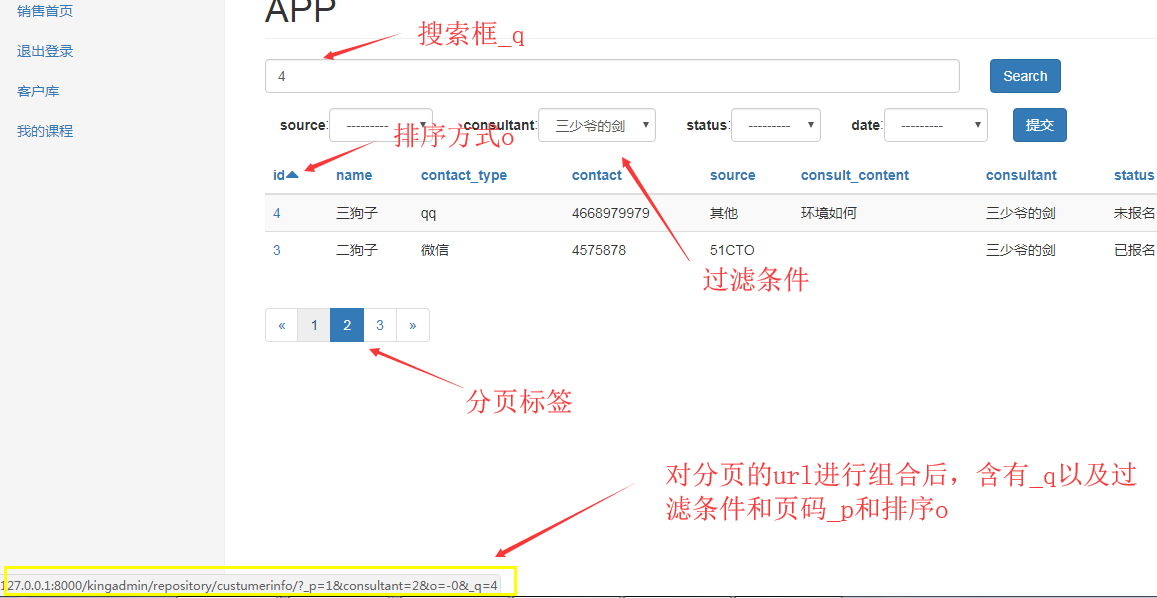
二:对各个字段筛选(对kingadmin中list_filter字段进行筛选)
1:前端显示

<div class="form-group"> <form method="get" class="form-inline"> {% for field in admin_class.list_filter %} {% build_filter_row field admin_class %} {% endfor %} {% build_order_filter admin_class %} <button type="submit" class="btn btn-primary">提交</button> </form> </div>
2.模板函数去定制标签,在form表单中加入隐藏标签(表示排序和搜索条件)

@register.simple_tag def build_filter_row(field,admin_class): model = admin_class.model field_obj = model._meta.get_field(field) filter_conditions = admin_class.filter_conditions label = """<label class="control-label">%s</label>"""%field try: select = "<div class='col-md-3'>%s:<select class='form-control' name='%s'>"%(label,field) data_list = field_obj.get_choices(field) #可以获取choices选项和外键 except AttributeError: if field_obj.get_internal_type() in ("DateField","DateTimeField"): field = "%s__gte"%field select = "<div class='col-md-2'>%s:<select class='form-control' name='%s'>"%(label,field) time_now = datetime.now() time_list = [ ["", "---------"], [time_now, "today"], [time_now - timedelta(7), "七天内"], [time_now.replace(day=1), "本月"], [time_now - timedelta(90), "三个月内"], [time_now.replace(month=1, day=1), "今年内"], ['', "ALL"] ] def turn_date(date_list): date_obj, date_str = date_list if type(date_obj) is datetime: date_obj = date_obj.strftime("%Y-%m-%d") return (date_obj,date_str) data_list = map(turn_date,time_list) else: select = "<div class='col-md-3'>%s:<select class='form-control' name='%s'>"%(label,field) data_list = list(model.objects.values_list("id",field)) for item in data_list: if str(item[0]) == filter_conditions.get(field,None): option = "<option value='%s' selected>" % str(item[0]) else: option = "<option value='%s'>"%str(item[0]) option += item[1] option += "</option>" select += option select += "</select></div>" return mark_safe(select)
3.在views中将url中的各个条件,放置到admin_class中,方便模板标签的使用

@login_required def table_obj_list(request,app_name,model_name): '''取出指定的数据返给前端''' admin_class = site.enabled_admins[app_name][model_name] model_class = admin_class.model querysets = model_class.objects.all() #所有数据 #搜索后的数据 querysets,search_conditions = get_search_result(request,querysets,admin_class) admin_class.search_conditions = search_conditions querysets,filter_conditions = get_filter_result(request,querysets) #过滤条件后的数据 admin_class.filter_conditions = filter_conditions #也可以传值给前端,但是这样也不错 querysets, sort_conditions = get_order_result(request,querysets,admin_class) admin_class.sort_conditions = sort_conditions current_page = request.GET.get('_p',1) paginator = CustomPagimator.CustomPagimator(current_page=current_page, max_page_num=3,object_list=querysets,per_page=2) # 传入总数据和每页显示的数据 try: filter_data = paginator.page(current_page) except PageNotAnInteger: filter_data = paginator.page(1) except EmptyPage: filter_data = paginator.page(paginator.num_pages) # num_pages数总页数,最后一页 page_html = paginator.page_num_range() return render(request,"kingadmin/table_obj_list.html",{"queryset":filter_data,'admin_class':admin_class,"page_html":page_html})
4.在views中的url数据获取时将其他_q搜索,o排序,_p分页数据过滤,获取所有数据

def get_filter_result(request,querysets): filter_conditions = {} for k,v in request.GET.items(): if k in ("_p","o","_q"):continue if v: filter_conditions[k] = v return querysets.filter(**filter_conditions),filter_conditions
推文:python---Django中模型类中Meta元对象了解,可以知道数据模型中的字段对象或者其他所需要的内容
三:对各个字段进行排序(list_display)
1.前端传递排序数据,对于table中的th加上url

<thead>
<tr>
{% build_title_row admin_class %}
</tr>
</thead>
2.模板函数build_title_row 去生成标签

@register.simple_tag def build_title_row(admin_class): #先生成过滤条件 filter_conditions = '' for k, v in admin_class.filter_conditions.items(): filter_conditions += "&" + k + '=' + v; #再生成搜索条件 if admin_class.search_conditions: filter_conditions += "&_q="+admin_class.search_conditions icon = """<span class="glyphicon glyphicon-triangle-%s" aria-hidden="true"></span>""" title = '' th = "<th><a href='?o=%s%s'>%s%s</a></th>" try: sort_cond = list(admin_class.sort_conditions.keys())[0] sort_val = list(admin_class.sort_conditions.values())[0] except IndexError: sort_cond = None sort_val = None for counter,field in enumerate(admin_class.list_display): if field == sort_cond: if sort_val.startswith("-"): title += th%(sort_val.strip("-"),filter_conditions,field,icon%"top") else: title += th%("-"+sort_val,filter_conditions,field,icon%"bottom") else: title += th%(counter,filter_conditions,field,"") return mark_safe(title)
3.views中对我们获取的所有数据,根据前端传递的排序方法进行排序处理

def get_order_result(request,querysets,admin_class): order_index = request.GET.get("o") sort_conditions = {} if order_index: index = abs(int(order_index)) order_by = admin_class.list_display[index] if order_index.startswith("-"): querysets = querysets.order_by("-"+order_by) else: querysets = querysets.order_by(order_by) sort_conditions[order_by] = order_index return querysets,sort_conditions
四:对字段进行搜索(search_fields)
1.前端生成标签时,form表单中需要一起传递其他条件的input隐藏框

<form class="form-horizontal" method="get" role="form"> <div class="form-group"> <div class="col-sm-8"> <input class="form-control" id="focusedInput" name="_q" placeholder="输入数据开始搜索...." value="{{ admin_class.search_conditions }}" type="text"> {% build_search_filter admin_class %} </div> <div class="col-sm-2"> <input type="submit" class="btn btn-primary" value="Search"> </div> </div> </form>
2.使用模板函数生成标签

@register.simple_tag def build_search_filter(admin_class): '''向搜索框中添加入过滤条件和排序条件''' # 先生成过滤条件 inp = "" for k, v in admin_class.filter_conditions.items(): inp += """<input type="hidden" name="%s" value="%s"/>"""%(k,v) # 再生成排序条件 if admin_class.sort_conditions: inp += """<input type="hidden" name="%s" value="%s"/>""" % ("o", list(admin_class.sort_conditions.values())[0]) return mark_safe(inp)
3.后端处理搜索条件,生成querysets数据

def get_search_result(request,querysets,admin_class): search_val = request.GET.get("_q") if search_val: q = Q() q.connector = "OR" for field in admin_class.search_fields: q.children.append(("%s__contains"%field,search_val)) querysets = querysets.filter(q) return querysets,search_val
Day4:动态生成任意表的CURD
1.如何在前端动态生成标签?使用form验证可以针对model生成所有的字段控件
推文:python---django中form组件(2)自定制属性以及表单的各种验证,以及数据源的实时更新,以及和数据库关联使用ModelForm和元类

from django.forms import ModelForm from repository import models class CustomerForm(ModelForm): class Meta: model = models.CustumerInfo #将表与元类中的数据关联 fields = "__all__" def __new__(cls, *args, **kwargs): print(cls.base_fields) #OrderedDict([('name', <django.forms.fields.CharField object at 0x00000000047FE9E8>), ('contact_type', <django.forms.fields.TypedChoiceField object at 0x00000000047FEBA8>), ('contact', <django.forms.fields.CharField object at 0x00000000047FECC0>), ('source', <django.forms.fields.TypedChoiceField object at 0x00000000047FEE10>), ('referral_from', <django.forms.models.ModelChoiceField object at 0x00000000047FEEF0>), ('consult_courses', <django.forms.models.ModelMultipleChoiceField object at 0x000000000480B048>), ('consult_content', <django.forms.fields.CharField object at 0x000000000480B0B8>), ('status', <django.forms.fields.TypedChoiceField object at 0x000000000480B208>), ('consultant', <django.forms.models.ModelChoiceField object at 0x000000000480B2E8>)]) #这张表中的所有字段对象 for field_name,field_obj in dict(cls.base_fields).items(): field_obj.widget.attrs.update({'class':"form-control"}) return ModelForm.__new__(cls)
2.如何针对每张表动态生成一个Form类?需要用到type方法去动态生成类

from django.forms import ModelForm from repository import models def create_dynamic_model_form(admin_class,form_add = False): '''动态生成modelform,form_add表示是添加数据生成form类。添加和编辑有所区别''' class Meta: model = admin_class.model # 将表与元类中的数据关联 fields = "__all__" if not form_add: exclude = admin_class.readonly_fields admin_class.add_flag = False else: exclude = [] admin_class.add_flag = True def __new__(cls, *args, **kwargs): #OrderedDict([('name', <django.forms.fields.CharField object at 0x00000000047FE9E8>), ('contact_type', <django.forms.fields.TypedChoiceField object at 0x00000000047FEBA8>), ('contact', <django.forms.fields.CharField object at 0x00000000047FECC0>), ('source', <django.forms.fields.TypedChoiceField object at 0x00000000047FEE10>), ('referral_from', <django.forms.models.ModelChoiceField object at 0x00000000047FEEF0>), ('consult_courses', <django.forms.models.ModelMultipleChoiceField object at 0x000000000480B048>), ('consult_content', <django.forms.fields.CharField object at 0x000000000480B0B8>), ('status', <django.forms.fields.TypedChoiceField object at 0x000000000480B208>), ('consultant', <django.forms.models.ModelChoiceField object at 0x000000000480B2E8>)]) #这张表中的所有字段对象 for field_name,field_obj in dict(cls.base_fields).items(): field_obj.widget.attrs.update({'class':"form-control"}) # if field_name in admin_class.readonly_fields: # field_obj.widget.attrs.update({'disabled':'true'}) return ModelForm.__new__(cls) dynamic_form = type("DynamicModelForm",(ModelForm,),{'Meta':Meta,"__new__":__new__}) return dynamic_form
3.在修改页面中动态创建Form类(需要传递原来数据)

@login_required def table_obj_change(request,app_name,model_name,obj_id): '''kingadmin数据修改页面''' admin_class = site.enabled_admins[app_name][model_name] #动态生成form表单 model_form = form_handle.create_dynamic_model_form(admin_class) obj = admin_class.model.objects.get(id=obj_id) if request.method == "GET": form_obj = model_form(instance=obj) elif request.method == "POST": form_obj = model_form(instance=obj,data=request.POST) if form_obj.is_valid(): form_obj.save() return redirect("/kingadmin/%s/%s"%(app_name,model_name)) return render(request,"kingadmin/table_obj_change.html",locals())

url(r"^(w+)/(w+)/(d+)/change/$", views.table_obj_change, name="table_obj_change"),

4.在添加页面动态创建Form类

@login_required def table_obj_add(request,app_name,model_name): admin_class = site.enabled_admins[app_name][model_name] model_form = form_handle.create_dynamic_model_form(admin_class,form_add = True) if request.method == "GET": form_obj = model_form() elif request.method == "POST": form_obj = model_form(data=request.POST) if form_obj.is_valid: form_obj.save() return redirect("/kingadmin/%s/%s" % (app_name, model_name)) return render(request,"kingadmin/table_obj_add.html",locals())

url(r"^(w+)/(w+)/add/$", views.table_obj_add, name="table_obj_add")
 添加的url
添加的url
5.修改和添加的HTML和公共部分

{% extends "kingadmin/index.html" %}
{% load my_func %}
{% block right-content-container %}
<h2 class="page-header">{% get_model_name admin_class %}</h2>
<h3 class="page-header">添加{% get_model_name admin_class %}</h3>
<div>
add
{% include "kingadmin/table_obj_change_component.html" %}
</div>
{% endblock %}

{% extends "kingadmin/index.html" %}
{% load my_func %}
{% block right-content-container %}
<h2 class="page-header">{% get_model_name admin_class %}</h2>
<h3 class="page-header">修改{{ form_obj.instance }}</h3>
<div>
change
{% include "kingadmin/table_obj_change_component.html" %}
</div>
{% endblock %}

{% load my_func %}
<form class="form-horizontal" onsubmit="ChangeSelStatus(this);" method="post" role="form">
{% csrf_token %}
{% for field in form_obj %}
<div class="form-group">
<label class="col-sm-2 control-label">{{ field.label }}</label>
{% if field.name in admin_class.filter_horizontal %}
<div class="col-sm-5">
<select class="form-control" name="" id="id_{{ field.name }}_from" multiple>
{% get_rel_m2m_val field.name admin_class as rel_querysets %}
{% for rel_obj in rel_querysets %}
{% get_rel_m2m_sel form_obj field.name rel_obj as sel_flag%}
{% if not sel_flag %}
<option ondblclick="MoveEleToOpp(this,'{{ field.name }}');" value="{{ rel_obj.id }}">{{ rel_obj }}</option>
{% endif %}
{% endfor %}
</select>
</div>
<div class="col-sm-5">
<select tag="submit" class="form-control" name="{{ field.name }}" id="id_{{ field.name }}_to" multiple>
{% get_rel_m2m_val field.name admin_class as rel_querysets %}
{% for rel_obj in rel_querysets %}
{% get_rel_m2m_sel form_obj field.name rel_obj as sel_flag%}
{% if sel_flag %}
<option ondblclick="MoveEleToOpp(this,'{{ field.name }}');" value="{{ rel_obj.id }}">{{ rel_obj }}</option>
{% endif %}
{% endfor %}
</select>
</div>
{% else %}
<div class="col-sm-10">
{{ field }}
<span style="color: red;">
{{ field.errors.0 }}
</span>
</div>
{% endif %}
</div>
{% endfor %}
{% if not admin_class.add_flag %}
{% for field_name in admin_class.readonly_fields %}
<div class="form-group">
<label class="col-sm-2 control-label">{{ field_name }}</label>
<div class="col-sm-10">
<p class="text-left">{% get_field_value_p field_name form_obj %}</p>
</div>
</div>
{% endfor %}
{% endif %}
<div class="col-lg-offset-11 col-sm-1">
<input type="submit" class="btn btn-success" value="Save">
</div>
</form>
{% block extra-js %}
<script>
function MoveEleToOpp(ths,field_name) {
if($(ths).parent().prop("id") == "id_"+field_name+"_from"){
var new_target = "id_"+field_name+"_to";
}else{
var new_target = "id_"+field_name+"_from";
}
$("#"+new_target).append(ths);
}
function ChangeSelStatus(ths){
$("select[tag] option").prop("selected",true);
}
</script>
{% endblock %}
6.处理在add和change中对于readonly_fileds字段的不同

{% if not admin_class.add_flag %}
{% for field_name in admin_class.readonly_fields %}
<div class="form-group">
<label class="col-sm-2 control-label">{{ field_name }}</label>
<div class="col-sm-10">
<p class="text-left">{% get_field_value_p field_name form_obj %}</p>
</div>
</div>
{% endfor %}
{% endif %}
7.对于filter_horizontal字段我们在模板函数中进行获取所有的值,并且判断是否显示在哪一个select标签中

<div class="col-sm-5"> <select class="form-control" name="" id="id_{{ field.name }}_from" multiple> {% get_rel_m2m_val field.name admin_class as rel_querysets %} {% for rel_obj in rel_querysets %} {% get_rel_m2m_sel form_obj field.name rel_obj as sel_flag%} {% if not sel_flag %} <option ondblclick="MoveEleToOpp(this,'{{ field.name }}');" value="{{ rel_obj.id }}">{{ rel_obj }}</option> {% endif %} {% endfor %} </select> </div> <div class="col-sm-5"> <select tag="submit" class="form-control" name="{{ field.name }}" id="id_{{ field.name }}_to" multiple> {% get_rel_m2m_val field.name admin_class as rel_querysets %} {% for rel_obj in rel_querysets %} {% get_rel_m2m_sel form_obj field.name rel_obj as sel_flag%} {% if sel_flag %} <option ondblclick="MoveEleToOpp(this,'{{ field.name }}');" value="{{ rel_obj.id }}">{{ rel_obj }}</option> {% endif %} {% endfor %} </select> </div>

@register.simple_tag def get_rel_m2m_val(field_name,admin_class): field_obj = admin_class.model._meta.get_field(field_name) rel_model = field_obj.related_model querysets = rel_model.objects.all() return querysets

@register.simple_tag def get_rel_m2m_sel(form_obj,field_name,rel_obj): try: querysets = getattr(form_obj.instance, field_name).all() if rel_obj in querysets: return True return False except TypeError: return False
8.实现js双击option,在两个select之间跳转



<option ondblclick="MoveEleToOpp(this,'{{ field.name }}');" value="{{ rel_obj.id }}">{{ rel_obj }}</option>

function MoveEleToOpp(ths,field_name) { if($(ths).parent().prop("id") == "id_"+field_name+"_from"){ var new_target = "id_"+field_name+"_to"; }else{ var new_target = "id_"+field_name+"_from"; } $("#"+new_target).append(ths); }
9.实现在点击保存时,form表单自动将右侧select中的数据全部选中。注意:加上name为select标签,name="字段名"

<form class="form-horizontal" onsubmit="ChangeSelStatus(this);" method="post" role="form">

function ChangeSelStatus(ths){ $("select[tag] option").prop("selected",true); }
10.为filter_horizontal完善功能,添加全选,全部移除


<p><a onclick="ChooseAll(this,'{{ field.name }}')">ChooseAll</a></p> <p><a onclick="ChooseAll(this,'{{ field.name }}')">RemoveAll</a></p>

function ChooseAll(ths,field_name) { var sel_id = $(ths).parent().prev().prop("id") if(sel_id == "id_"+field_name+"_from"){ var new_target = "id_"+field_name+"_to"; }else{ var new_target = "id_"+field_name+"_from"; } $("#"+sel_id).find("option").each(function(){ $("#"+new_target).append(this); }) }
Day5:删除功能开发和action方法实现
1.删除功能开发



{% extends "kingadmin/index.html" %}
{% load my_func %}
{% block right-content-container %}
<h2 class="page-header">{% get_model_name admin_class %}</h2>
<h3 class="page-header alert-danger">注意:以下与{{ obj }}想关联的数据都将被删除</h3>
<div>
{% get_del_obj obj app_name model_name as res_del %}
{{ res_del|safe }}
</div>
<form method="post">
{% csrf_token %}
<input type="submit" class="btn btn-danger" value="确认删除">
<a href="/kingadmin/{{ app_name }}/{{ model_name }}/{{ obj.id }}/change" class="btn btn-primary">返回</a>
</form>
{% endblock %}

@register.simple_tag def get_del_obj(model_obj, app_name, model_name): all_rel = model_obj._meta.related_objects ul = "<ul>" ul += "<li>%s:<a href='/kingadmin/%s/%s/%s/change'>%s</a></li>"%(model_obj._meta.label.rsplit('.',maxsplit=1)[1],app_name,model_name,model_obj.id,model_obj) for rel_field in all_rel: sub_querysets = getattr(model_obj,rel_field.name+"_set").all() if not sub_querysets: #若是关联但是没有数据,则不显示 continue if rel_field.get_internal_type() == "ManyToManyField": ul += "<li><ul>" ul += "<li>%s</li>"%rel_field.name for i in sub_querysets: ul += "<li><ul><li>%s</li></ul></li>" % i ul += "</ul></li>" else: for sub_item in sub_querysets: sub_res = get_del_obj(sub_item,sub_item._meta.app_label,sub_item._meta.model_name) ul += "<li>%s</li>"%(sub_res) ul += "</ul>" return ul

@login_required def table_obj_delete(request,app_name,model_name,obj_id): admin_class = site.enabled_admins[app_name][model_name] obj = admin_class.model.objects.get(id=obj_id) if request.method == "POST": obj.delete() return redirect("/kingadmin/{app_name}/{model_name}".format(app_name=app_name,model_name=model_name)) return render(request, "kingadmin/table_obj_delete.html", locals())
2.action字段功能完善

class CustomerAdmin(BaseKingAdmin): list_display = ['id','name','contact_type','contact','source','consult_content','consultant','status','date'] list_filter = ['source','consultant','status','date'] search_fields = ['contact','consultant__name','name'] readonly_fields = ['status','contact'] filter_horizontal = ['consult_courses',] action = ['change_status',] def change_status(self,request,querysets): querysets.update(status=1)

from django.shortcuts import render class BaseKingAdmin(object): list_display = [] list_filter = [] search_fields = [] readonly_fields = [] filter_horizontal = [] action = [] def_action = ['delete_selected_objs'] def delete_selected_objs(self,request,querysets): return render(request,'kingadmin/table_obj_delete.html') def __init__(self): self.action.extend(self.def_action)

(1)设置form表单布局

<div>
<form action="" method="post" class="form-inline" onsubmit="return Raw_input_action(this);">
<div class="col-lg-3">
{% csrf_token %}
<label class="control-label">Action:</label>
<select name="action" id="action" class="form-control">
<option value="">---------</option>
{% for action in admin_class.action %}
<option value="{{ forloop.counter0 }}">{{ action }}</option>
{% endfor %}
</select>
</div>
<div class="col-sm-2">
<input type="submit" value="Go" class="btn btn-primary">
</div>
</form>
</div>
(2)设置复选框完成全选功能

<div>
<table class="table table-striped">
<thead>
<tr>
<th><input type="checkbox" id="check_All" onclick="CheckAll(this)"/></th>
{% build_title_row admin_class %}
</tr>
</thead>
<tbody>
{% for item in queryset %}
<tr>
<td><input type="checkbox" name="check_row" value="{{ item.id }}"></td>
{% build_table_row item admin_class %}
</tr>
{% endfor %}
</tbody>
</table>
</div>

function CheckAll(ths) { if($(ths).prop("checked")){ $("input[name=check_row]").prop("checked",true) }else{ $("input[name=check_row]").prop("checked",false) } }
(3)提交表单前先生成隐藏表单去获取数据集

function Raw_input_action(ths) { if($("#action").val() == ""){ alert("请选择正确的action"); return false; } var select_ids = []; $("input[name=check_row]").filter(":checked").each(function(){ select_ids.push($(this).val()); }) if(select_ids.length == 0){ alert("请选择正确的项目"); return false; } new_ele = "<input type='hidden' name='select_ids' value='"+JSON.stringify(select_ids)+"'/>"; $(ths).append(new_ele); return true; }
(4)传递到后端进行处理

@login_required def table_obj_list(request,app_name,model_name): '''取出指定的数据返给前端''' admin_class = site.enabled_admins[app_name][model_name] model_class = admin_class.model querysets = model_class.objects.all() #所有数据 if request.method == "POST": selected_action = request.POST.get("action") selected_ids = request.POST.get("select_ids") getattr(admin_class,admin_class.action[int(selected_action)])(request,querysets.filter(id__in=json.loads(selected_ids)))
3.处理action中的默认行为delete批量删除

(1)提交的url不是上面的table_obj_delete,而是本页面和change_status一起作为action传递入当前url


def delete_selected_objs(self,request,querysets): return render(request,'kingadmin/table_obj_delete.html',{"admin_class":self,'obj':querysets})
(2)获取delete_selected_objs在table_obj_list方法中返回

if request.method == "POST": if request.POST.get("delete_ids"): '''如果是删除做post传递过来的话另外处理,否则就是action操作''' del_id = json.loads(request.POST.get("delete_ids")) admin_class.model.objects.filter(id__in=del_id).delete() return redirect("/kingadmin/%s/%s"%(app_name,model_name)) else: selected_action = request.POST.get("action") selected_ids = request.POST.get("select_ids") res = getattr(admin_class,admin_class.action[int(selected_action)])(request,querysets.filter(id__in=json.loads(selected_ids))) #如果返回值,代表是返回render指向delete页面 if res: return res
若是执行完action方法后没有返回值则是正常执行,如果有返回值,则是代表我们接下来是执行删除操作。需要返回
(3)我们还是调用的上面的table_obj_delete.html页面,但是其中的模板标签函数,是针对一个数据对象,而现在是一个数据集,我们需要再次处理

@register.simple_tag def get_del_obj(model_objs, app_name, model_name): ul = "<ul>" try: iter(model_objs) except TypeError: model_objs = [model_objs,] for model_obj in model_objs: all_rel = model_obj._meta.related_objects ul += "<li>%s:<a href='/kingadmin/%s/%s/%s/change'>%s</a></li>"%(model_obj._meta.label.rsplit('.',maxsplit=1)[1],app_name,model_name,model_obj.id,model_obj) for rel_field in all_rel: sub_querysets = getattr(model_obj,rel_field.name+"_set").all() if not sub_querysets: #若是关联但是没有数据,则不显示 continue if rel_field.get_internal_type() == "ManyToManyField": ul += "<li><ul>" ul += "<li>%s</li>"%rel_field.name for i in sub_querysets: ul += "<li><ul><li>%s</li></ul></li>" % i ul += "</ul></li>" else: for sub_item in sub_querysets: sub_res = get_del_obj(sub_item,sub_item._meta.app_label,sub_item._meta.model_name) ul += "<li>%s</li>"%(sub_res) ul += "</ul>" return ul
(4)我们提交数据,也不再是table_obj_delete方法,而是table_obj_list方法,所以我们需要传递一个数据代表要删除的数据id集合,同时一个一个标识

<input type="hidden" name="delete_ids" value="{% get_del_objs_id obj %}">

@register.simple_tag def get_del_objs_id(objs): obj_ser = [] for obj in objs: obj_ser.append(obj.id) return json.dumps(obj_ser)
(5)views页面根据post传递过来的隐藏标签的name,判断是不是执行删除数据操作

if request.method == "POST": if request.POST.get("delete_ids"): '''如果是删除做post传递过来的话另外处理,否则就是action操作''' del_id = json.loads(request.POST.get("delete_ids")) admin_class.model.objects.filter(id__in=del_id).delete() return redirect("/kingadmin/%s/%s"%(app_name,model_name))
4.实现面包屑导航






<ol class="breadcrumb"> <li><a href="/kingadmin">CRM</a></li> <li><a href="/kingadmin/{{ app_name }}">{{ app_name }}</a></li> <li><a href="/kingadmin/{{ app_name }}/{{ model_name }}">{{ model_name }}</a></li> <li class="active">{% get_nva_active admin_class %}</li> </ol>

<ol class="breadcrumb"> <li><a href="/kingadmin">CRM</a></li> <li><a href="/kingadmin/{{ app_name }}">{{ app_name }}</a></li> <li><a href="/kingadmin/{{ app_name }}/{{ model_name }}">{{ model_name }}</a></li> <li class="active">{% get_nva_active admin_class %}</li> </ol>

<ol class="breadcrumb"> <li><a href="/kingadmin">CRM</a></li> <li><a href="/kingadmin/{{ app_name }}">{{ app_name }}</a></li> <li><a href="/kingadmin/{{ app_name }}/{{ model_name }}">{{ model_name }}</a></li> <li class="active">{{ form_obj.instance }}</li> </ol>

@register.simple_tag def get_nva_active(admin_class): return admin_class.model._meta.verbose_name

<ol class="breadcrumb"> <li><a href="/kingadmin">CRM</a></li> <li><a href="/kingadmin/{{ app_name }}">{{ app_name }}</a></li> <li><a href="/kingadmin/{{ app_name }}/{{ model_name }}">{{ model_name }}</a></li> <li class="active">{% get_nav_del obj %}</li> </ol>

@register.simple_tag def get_nav_del(model_objs): obj_names = [] try: iter(model_objs) except TypeError: model_objs = [model_objs,] for model in model_objs: obj_names.append("%s"%model) return '|'.join(obj_names)
5.左侧菜单状态
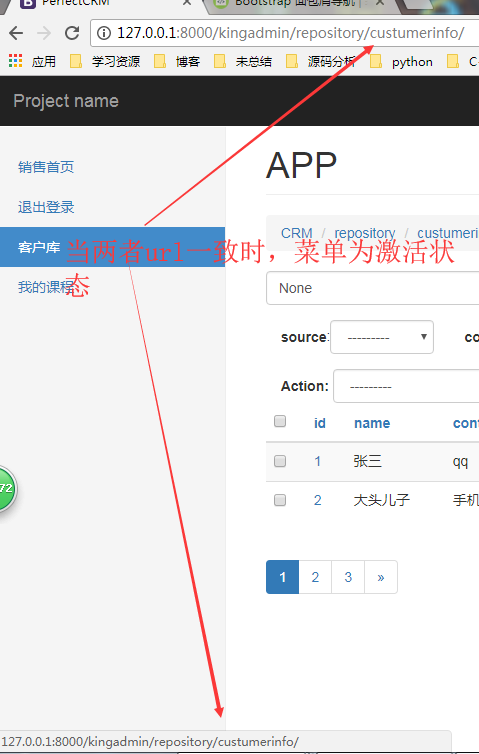

{% for menu in role.menus.select_related %}
{% if menu.url_type == 0 %}
{% if menu.url_name == request.path %}
<li class="active"><a href="{{ menu.url_name }}">{{ menu.name }}</a></li>
{% else %}
<li><a href="{{ menu.url_name }}">{{ menu.name }}</a></li>
{% endif %}
{% else %}
{% url menu.url_name as url_name %}
{% if url_name == request.path %}
<li class="active"><a href="{{ url_name }}">{{ menu.name }}</a></li>
{% else %}
<li><a href="{{ url_name }}">{{ menu.name }}</a></li>
{% endif %}
{% endif %}
{% endfor %}
Day6:学员报名流程开发

class ContractTemplate(models.Model): '''合同模板表''' name = models.CharField(max_length=64) content = models.TextField() date = models.DateField(auto_now_add=True) def __str__(self): return self.name class StudentEnrollment(models.Model): '''学员报名表:这里还没有变成学员,适合客户表相关联''' customer = models.ForeignKey("CustumerInfo") class_grade = models.ForeignKey("ClassList") consultant = models.ForeignKey("UserProfile") #对应的销售 contract_agreed = models.BooleanField(default=False) #是否同意合同 contract_signed_date = models.DateTimeField(blank=True,null=True) #同意合同未到时间 contract_approved = models.BooleanField(default=False) #审核是否完毕 contract_approved_date = models.DateTimeField(blank=True,null=True) class Meta: unique_together = ("customer","class_grade") def __str__(self): return "%s"%self.customer class PaymentRecord(models.Model): '''存储学员缴费记录''' enrollment = models.ForeignKey("StudentEnrollment") payment_type_choice = ( (0,"报名费"), (1,"学费"), (2,"退费"), ) payment_type = models.SmallIntegerField(choices=payment_type_choice) amount = models.IntegerField("费用",default=500) consultant = models.ForeignKey("UserProfile") #费用缴给谁 date = models.DateTimeField(auto_now_add=True) def __str__(self): return "%s"%self.enrollment
一:销售为想报名的学员提供链接
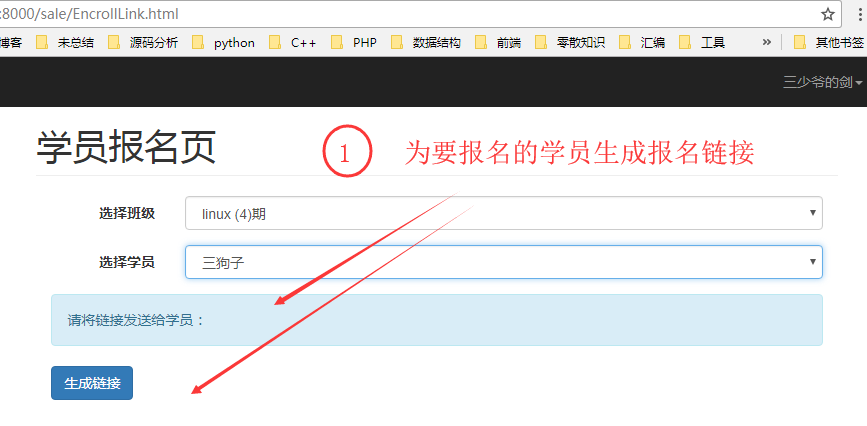
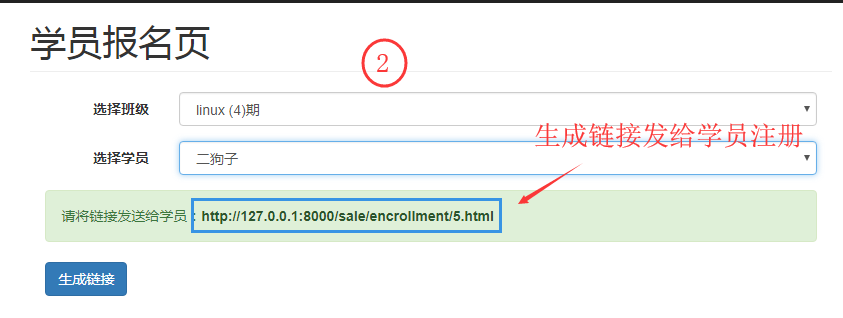

@login_required def Student_encroll(request): ClassList = models.ClassList.objects.all() StuEncroll = models.CustumerInfo.objects.filter(consultant__user=request.user).all() if request.method == "POST": student = request.POST.get("student") classlist = request.POST.get("classlist") try: StuEncObj = models.StudentEnrollment.objects.create( customer_id=student, class_grade_id=classlist, consultant=request.user.userprofile ) except IntegrityError: StuEncObj = models.StudentEnrollment.objects.get( customer_id=student, class_grade_id=classlist, consultant=request.user.userprofile ) if StuEncObj.contract_agreed: return redirect("encrollment/%s/contract_audit.html"%StuEncObj.id) else: return HttpResponse("等待学员身份验证") link = "http://127.0.0.1:8000/sale/encrollment/%s.html"%StuEncObj.id return render(request,"sale/stu_encroll.html",locals())
二:学员获取链接,进行填写信息,查阅合同,同意并上传证件信息



def enrollment(request,id): '''学员在线报名''' enrollment_obj = models.StudentEnrollment.objects.get(id=id) if enrollment_obj.contract_agreed and not enrollment_obj.contract_approved: return HttpResponse("信息正在审核当中") if enrollment_obj.contract_approved: return HttpResponse("审核通过,去进行缴费操作") if request.method == "GET": forms = CustomerForm(instance=enrollment_obj.customer) elif request.method == "POST": if not request.POST.get("contract_agreed"): return HttpResponse("信息提交失败,请先阅读合同") cus_dir = os.path.join(conf.settings.SALE_FILE_UPLOAD_DIR, id) if len(os.listdir(cus_dir)) == 0: return HttpResponse("信息提交失败,请先上传证件信息") forms = CustomerForm(instance=enrollment_obj.customer,data=request.POST) if forms.is_valid(): forms.save() enrollment_obj.contract_agreed = True enrollment_obj.contract_signed_date = datetime.datetime.now() enrollment_obj.save() return HttpResponse("信息提交成功") file_dir = os.path.join(conf.settings.SALE_FILE_UPLOAD_DIR,id) if os.path.isdir(file_dir): file_info = os.listdir(file_dir) return render(request,"sale/enrollment.html",locals())

{% extends "index.html" %}
{% block extra-link %}
<link rel="stylesheet" href="/static/plugins/dropzone/dropzone.css">
{% endblock %}
{% block body %}
<h1 class="page-header">学员报名</h1>
<div class="col-lg-offset-1 col-lg-10">
<div class="panel panel-info">
<div class="panel-heading">
<h3 class="panel-title">学员在线报名</h3>
</div>
<div class="panel-body">
<form class="form-horizontal" onsubmit="return PrevSubmit(this);" method="post" role="form">
{% csrf_token %}
{% for field in forms %}
<div class="form-group col-sm-6">
<label class="col-sm-4 control-label">{{ field.label }}</label>
<div class="col-sm-8">
{{ field }}
<span style="color: red;">{{ field.errors.0 }}</span>
</div>
</div>
{% endfor %}
<div class="form-group col-sm-6">
<label class="col-sm-4 control-label">报名班级</label>
<div class="col-sm-8">
<p class="form-control-static">{{ enrollment_obj.class_grade }}</p>
</div>
</div>
<div class="form-group col-sm-6">
<label class="col-sm-4 control-label">学费</label>
<div class="col-sm-8">
<p class="form-control-static">{{ enrollment_obj.class_grade.couser.price }}</p>
</div>
</div>
<div class="col-sm-12">
<pre style="height: 400px">
{{ enrollment_obj.class_grade.contract_template.content }}
</pre>
<div>
<div class="form-inline">
<label class="col-sm-6 control-label" style="padding-top: 0px">是否同意以上合同</label>
<input type="checkbox" value="1" name="contract_agreed">
</div>
</div>
</div>
<div class="form-group col-sm-6">
<div class="col-sm-8">
<input type="submit" class="btn btn-success" value="提交">
</div>
</div>
</form>
<div class="col-sm-12">
<ul id="file_ul" style="list-style: none">
<label class="control-label" style="padding-top: 0px;">已上传的文件目录</label>
{% for file in file_info %}
<li>{{ file }}</li>
{% endfor %}
</ul>
<form action="{% url 'enrollment_fileupload' enrollment_obj.id %}" id="myAwesomeDropzone" class="dropzone">
<div class="fallback">
<input name="file" type="file" multiple />
</div>
</form>
</div>
</div>
</div>
</div>
{% endblock %}
{% block extra-js %}
<script src="/static/plugins/dropzone/dropzone.js"></script>
<script>
$(function () {
Dropzone.options.myAwesomeDropzone = {
paramName: "file", // The name that will be used to transfer the file
maxFilesize: 2, // MB
maxFiles:2,
parallelChunkUploads:true,
accept: function(file, done) {
if (file.name == "justinbieber.jpg") {
done("Naha, you don't.");
}
else { done(); }
},
init: function() {
this.on("success", function(file,respone) {
/* Maybe display some more file information on your page */
var rep = JSON.parse(respone)
if(!rep.status){
alert(rep.message);
return;
}else{
var li = "<li>"+file.name+"</li>";
$("#file_ul").append(li);
}
});
}
};
});
function PrevSubmit(ths){
if(!$($(ths).find(":checkbox[name=contract_agreed]")[0]).prop("checked")){
alert("请先阅读合同");
return false;
}
if($("#file_ul").find("li").length==0){
alert("请先上传证件信息");
return false;
}
$(ths).find(":disabled").removeAttr("disabled")
return true
}
</script>
{% endblock %}

@csrf_exempt def enrollment_fileupload(request,encrollment_obj_id): cus_dir = os.path.join(conf.settings.SALE_FILE_UPLOAD_DIR,encrollment_obj_id) if not os.path.isdir(cus_dir): os.makedirs(cus_dir) status = { 'status':True, "message":None } print(request.FILES) #需要去接收文件,前端状态才会是true if len(os.listdir(cus_dir)) >= 2: status['status'] = False status['message'] = "文件超出上传个数" return HttpResponse(json.dumps(status)) file_obj = request.FILES.get("file") with open(os.path.join(cus_dir,file_obj.name),"wb") as fp: for chunks in file_obj.chunks(): fp.write(chunks) return HttpResponse(json.dumps(status))
三:销售审核学员注册信息,审核通过,为其生成账号(密码需要使用Django模块加密),发送邮件


from django.contrib.auth.hashers import make_password #用于生成密码

@login_required def contract_audit(request,id): '''合同审查''' enrollment_obj = models.StudentEnrollment.objects.get(id=id) if not enrollment_obj.contract_agreed: return redirect("/sale/EncrollLink.html") if enrollment_obj.contract_approved: return HttpResponse("审核通过,等待缴费") if request.method == "GET": forms = CustomerForm(instance=enrollment_obj.customer) contract_forms = ContractForm(instance=enrollment_obj) elif request.method == "POST": forms = CustomerForm(instance=enrollment_obj.customer,data=request.POST) contract_forms = ContractForm(instance=enrollment_obj,data=request.POST) if forms.is_valid() and contract_forms.is_valid(): forms.save() contract_forms.save() enrollment_obj.contract_approved_date = datetime.datetime.now() enrollment_obj.save() try: stu_obj = enrollment_obj.customer.student except Exception: pass else: return HttpResponse( "用户%s已添加--->账号为:%s" % (enrollment_obj.customer.name, enrollment_obj.customer.student.account.name)) #生成一个随机字符串 account = ''.join(random.sample(string.digits,8)) pwd = ''.join(random.sample(string.ascii_letters+string.digits,8)) #创建一个账号 user = models.User.objects.create( username=account, password=make_password(pwd), ) #创建一个用户 userprofile = models.UserProfile.objects.create( user=user, name=enrollment_obj.customer.name, ) #为用户绑定一个角色 userprofile.role.add(models.Role.objects.get(name="Student")) #保存到学员表 models.Student.objects.create( customer=enrollment_obj.customer, class_grades=enrollment_obj.class_grade, account=userprofile, ) send_info = "账号:%s 密码:%s"%(account,pwd) send_mail( '成功成为正式学员', send_info, '18904190363@sina.cn', ["%s@qq.com"%enrollment_obj.customer.contact,], fail_silently=False, ) return HttpResponse("审核通过,等待缴费") print(forms.errors,contract_forms.errors) return render(request,"sale/contract_audit.html",locals())
Django自带邮件发送模块
(1)settings中配置

(2)导入模块发送邮件


day7:实现讲师和学员作业发布上传功能(其中由于多使用table浏览数据,可以自定义一个类似于form的基类,去统一实现table显示)
一:讲师功能
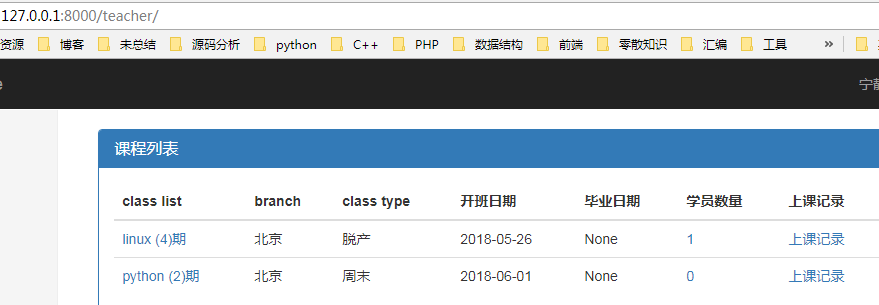


(1)可以看出上面多是table显示信息,下面自定义table_form类似于forms

import re class BaseForm(object): display_list = [] field_tag = {} attrs = {} extra_field = [] def __init__(self,model,querysets): self.instance = model self.querysets = querysets self.th = [] self.tr = [] def register(self): for field in self.display_list: if field == "self": self.th.append(self.instance._meta.verbose_name) continue field_obj = self.instance._meta.get_field(field) self.th.append(field_obj.verbose_name) #自定义额外字段 for item in self.extra_field: for k,v in item.items(): if v.get("verbose_name"): self.th.append(v.get("verbose_name")) else: self.th.append(k) for query in self.querysets: tds = [] for th in self.display_list: if th == "self": field_val = "%s" % query elif len(self.instance._meta.get_field(th).choices) > 0: field_val = "%s"%getattr(query,"get_%s_display"%th)() else: field_val = "%s"%getattr(query,th) if self.field_tag.get(th): # {"self": {"a": {"href": "127.0.0.1:8000","href": "127.0.0.1:8000"},"a": {"href": "127.0.0.1:8000"}}} tags = self.field_tag.get(th) # {"a": {"href": "127.0.0.1:8000", "href": "127.0.0.1:8000"}, "a": {"href": "127.0.0.1:8000"}} #前面是内层,后面是外层 for k,v in tags.items(): # "a": {"href": "127.0.0.1:8000", "href": "127.0.0.1:8000"} new_attr = [] for k1,v1 in v.items(): #{"href": "127.0.0.1:8000", "href": "127.0.0.1:8000"} pat = re.compile("{(.*?)}") res = pat.search(v1) while res: v1 = pat.sub(str(getattr(query,res.group(1))),v1,1) res = pat.search(v1) new_attr.append("%s='%s'"%(k1,v1)) #获取到所有的属性放在列表中 field_val = "<%s %s>%s</%s>"%(k," ".join(new_attr),field_val,k) tds.append(field_val) for item in self.extra_field: for e_k,e_v in item.items(): if e_v.get("value"): field_val = "%s" % e_v.get("value") else: if hasattr(e_v.get("function"),"__call__"): field_val = e_v.get("function")(getattr(query,e_v.get("model_attr")),*e_v.get("args",()),**e_v.get("kwargs",{})) else: field_val = getattr(getattr(query,e_v.get("model_attr")),e_v.get("function"))(*e_v.get("args",()),**e_v.get("kwargs",{})) if self.field_tag.get(e_k): # {"self": {"a": {"href": "127.0.0.1:8000","href": "127.0.0.1:8000"},"a": {"href": "127.0.0.1:8000"}}} tags = self.field_tag.get(e_k) # {"a": {"href": "127.0.0.1:8000", "href": "127.0.0.1:8000"}, "a": {"href": "127.0.0.1:8000"}} #前面是内层,后面是外层 for k,v in tags.items(): # "a": {"href": "127.0.0.1:8000", "href": "127.0.0.1:8000"} new_attr = [] for k1,v1 in v.items(): #{"href": "127.0.0.1:8000", "href": "127.0.0.1:8000"} pat = re.compile("{(.*?)}") res = pat.search(v1) while res: v1 = pat.sub(str(getattr(query, res.group(1))), v1, 1) res = pat.search(v1) new_attr.append("%s='%s'"%(k1,v1)) #获取到所有的属性放在列表中 field_val = "<%s %s>%s</%s>"%(k," ".join(new_attr),field_val,k) tds.append(field_val) self.tr.append(tds) def __str__(self): cls_attr = [] if len(self.attrs): for item in self.attrs.items(): cls_attr.append("%s='%s'"%(item[0],item[1])) tb = "<table %s>"%(" ".join(cls_attr)) tr = "<thead><tr>" for th_data in self.th: th = "<th>%s</th>"%th_data tr += th tr += "</tr></thead><tbody>" tb += tr for tr_data in self.tr: tr = "<tr>" for td_data in tr_data: td = "<td>%s</td>"%td_data tr += td tr += "</tr>" tb += tr tb += "</tbody></table>" return tb
(2)使用方法
from Teacher.table_form import BaseForm class ClassListForm(BaseForm): display_list = ["self","branch","class_type","start_date","graduate_date"] #self代表直接显示本条数据__str__ field_tag = {"self":{"a":{"href":"127.0.0.1:8000"},},"study_record":{"a":{"href":"/teacher/classlist/{id}/class_list.html"}},"student":{"a":{"href":"/teacher/classlist/{id}/student_list.html"}}} #在前面的标签会显示在内层,在显示的数据外面加上标签 attrs = {"class":"table table-hover"} #为table设置属性 extra_field = [{"student":{'verbose_name':"学员数量","model_attr":"student_set","function":"count"}},{"study_record":{"verbose_name":"上课记录","value":"上课记录"}}] #额外自定义字段,若是有值value,会直接输出,否则会去当前实例集self.querysets的每一个实例中去获取相关的数据,使用函数去执行。字符串是调用自己的内置方法,function是调用自定义方法,同时可以使用"args"传递元组,"kwargs":传递字典作为参数 def __init__(self,model,querysets): super(ClassListForm, self).__init__(model,querysets)

class StudentForm(BaseForm): display_list = ["self"] #,"couser","semester" field_tag = {"self":{"a":{"href":"127.0.0.1:8000"},},} #在前面的标签会显示在内层 attrs = {"class":"table table-hover"} extra_field = [{"student_grade":{'verbose_name':"学员成绩","value":"N/A"}},{"study_status":{"verbose_name":"出勤状况","value":"N/A"}}] #额外自定义字段,若是有值value,会直接输出,否则会去当前实例集self.querysets的每一个实例中去获取相关的数据,使用函数去执行。字符串是调用自己的内置方法,function是调用自定义方法 def __init__(self,model,querysets): super(StudentForm, self).__init__(model,querysets)

class CourseForm(BaseForm): display_list = ["self","title","content","has_homework","homework","date"] #,"couser","semester" field_tag = {"self":{"a":{"href":"127.0.0.1:8000"},},} #在前面的标签会显示在内层 attrs = {"class":"table table-hover"} extra_field = [] #额外自定义字段,若是有值value,会直接输出,否则会去当前实例集self.querysets的每一个实例中去获取相关的数据,使用函数去执行。字符串是调用自己的内置方法,function是调用自定义方法 def __init__(self,model,querysets): super(CourseForm, self).__init__(model,querysets)
(3)在views中调用各个tableform

@login_required def course_list(request): course_querysets = models.ClassList.objects.filter( teachers=request.user.userprofile ) #自定义form,用于table forms = ClassListForm(models.ClassList,course_querysets) forms.register() return render(request,"teacher/class_list.html",locals()) @login_required def student_list(request,c_id): student_querysets = models.ClassList.objects.filter( teachers = request.user.userprofile, id = c_id ).get().student_set.all() forms = StudentForm(models.Student,student_querysets) forms.register() return render(request,"teacher/student_list.html",locals()) @login_required def classRec_list(request,c_id): course_querysets = models.ClassList.objects.filter( teachers = request.user.userprofile, id = c_id ).get().courserecord_set.all() forms = CourseForm(models.CourseRecord,course_querysets) forms.register() return render(request, "teacher/course_list.html", locals())
(4)前端调用{{ forms|safe }},form是定义的tableform变量,实现简单显示页面

{% extends "index.html" %}
{% load my_func %}
{% block right-content-container %}
<div class="panel panel-primary">
<div class="panel-heading">
<h3 class="panel-title">课程列表</h3>
</div>
<div class="panel-body">
{{ forms|safe }}
</div>
</div>
{% endblock %}

{% extends "index.html" %}
{% load my_func %}
{% block right-content-container %}
<div class="panel panel-primary">
<div class="panel-heading">
<h3 class="panel-title">课程记录</h3>
</div>
<div class="panel-body">
{{ forms|safe }}
<a href="{% url 'classRec_add' c_id %}" class="btn btn-primary">添加记录</a>
</div>
</div>
{% endblock %}

{% extends "index.html" %}
{% load my_func %}
{% block right-content-container %}
<div class="panel panel-primary">
<div class="panel-heading">
<h3 class="panel-title">学员列表</h3>
</div>
<div class="panel-body">
{{ forms|safe }}
</div>
</div>
{% endblock %}
(5)添加记录

from django.forms import ModelForm,forms from repository import models class CustomerForm(ModelForm): class Meta: model = models.CustumerInfo #将表与元类中的数据关联 fields = "__all__" exclude = ["consult_content","status","consult_courses"] readonly_fields = ['contact_type',"contact","consultant",'referral_from','source'] def __new__(cls, *args, **kwargs): #OrderedDict([('name', <django.forms.fields.CharField object at 0x00000000047FE9E8>), ('contact_type', <django.forms.fields.TypedChoiceField object at 0x00000000047FEBA8>), ('contact', <django.forms.fields.CharField object at 0x00000000047FECC0>), ('source', <django.forms.fields.TypedChoiceField object at 0x00000000047FEE10>), ('referral_from', <django.forms.models.ModelChoiceField object at 0x00000000047FEEF0>), ('consult_courses', <django.forms.models.ModelMultipleChoiceField object at 0x000000000480B048>), ('consult_content', <django.forms.fields.CharField object at 0x000000000480B0B8>), ('status', <django.forms.fields.TypedChoiceField object at 0x000000000480B208>), ('consultant', <django.forms.models.ModelChoiceField object at 0x000000000480B2E8>)]) #这张表中的所有字段对象 for field_name,field_obj in dict(cls.base_fields).items(): field_obj.widget.attrs.update({'class':"form-control"}) if field_name in cls.Meta.readonly_fields: field_obj.widget.attrs.update({'disabled': "true"}) return ModelForm.__new__(cls) def clean(self): if self.errors: raise forms.ValidationError("Please fix errors before re-submit") if self.instance.id is not None: #这是一个修改的表单,而不是添加 for field_name in self.Meta.readonly_fields: new_val = self.cleaned_data[field_name] old_val = getattr(self.instance, field_name) if new_val != old_val: self.add_error(field_name, "ReadOnly fileds error: you cannot change %s"%old_val) class CourseRecordForm(ModelForm): class Meta: model = models.CourseRecord #将表与元类中的数据关联 fields = "__all__" # exclude = ["teacher"] def __new__(cls, *args, **kwargs): #OrderedDict([('name', <django.forms.fields.CharField object at 0x00000000047FE9E8>), ('contact_type', <django.forms.fields.TypedChoiceField object at 0x00000000047FEBA8>), ('contact', <django.forms.fields.CharField object at 0x00000000047FECC0>), ('source', <django.forms.fields.TypedChoiceField object at 0x00000000047FEE10>), ('referral_from', <django.forms.models.ModelChoiceField object at 0x00000000047FEEF0>), ('consult_courses', <django.forms.models.ModelMultipleChoiceField object at 0x000000000480B048>), ('consult_content', <django.forms.fields.CharField object at 0x000000000480B0B8>), ('status', <django.forms.fields.TypedChoiceField object at 0x000000000480B208>), ('consultant', <django.forms.models.ModelChoiceField object at 0x000000000480B2E8>)]) #这张表中的所有字段对象 for field_name,field_obj in dict(cls.base_fields).items(): field_obj.widget.attrs.update({'class':"form-control"}) return ModelForm.__new__(cls)

@login_required def classRec_add(request,c_id): if request.method == "GET": CRfm = forms.CourseRecordForm() else: CRfm = forms.CourseRecordForm(data=request.POST) CRfm.save() return redirect("/teacher/classlist/%s/course_list.html"%c_id) return render(request,"teacher/course_add.html",locals())

{% extends "index.html" %}
{% load my_func %}
{% block right-content-container %}
<div class="panel panel-primary">
<div class="panel-heading">
<h3 class="panel-title">课程记录添加</h3>
</div>
<div class="panel-body">
<form action="" method="post" class="form-group form-horizontal">
{% csrf_token %}
{% for field in CRfm %}
<div class="col-sm-6">
<div class="col-lg-4">
<label for="" class="control-label">{{ field.label }}</label>
</div>
<div class="col-lg-8">
{{ field }}
</div>
</div>
{% endfor %}
<div>
<input type="submit" class="btn btn-primary" value="添加">
</div>
</form>
</div>
</div>
{% endblock %}
二:学员功能,实现课程显示,作业提交
(一)根据邮件中的账号密码登录
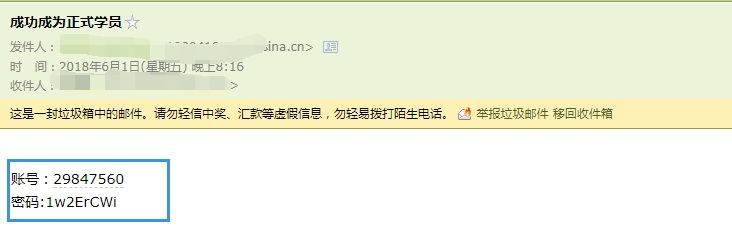
(二)实现查看班级,查看课程记录,提交作业


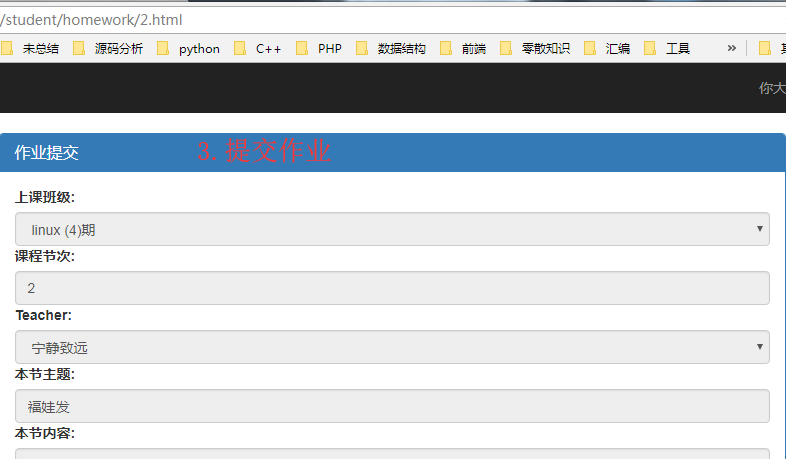
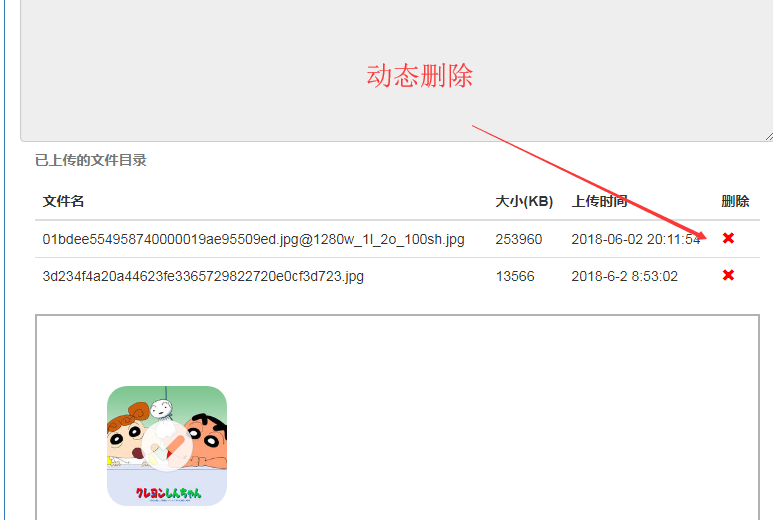
(1)由于这里也是table多使用,可以继续使用tableform
from Teacher.table_form import BaseForm class ClassListForm(BaseForm): display_list = ["self","class_type","start_date","graduate_date",] #,"couser","semester" field_tag = {"self":{"a":{"href":"127.0.0.1:8000"},},'score':{"a":{"href":"127.0.0.1:8080"},},'mng_homework':{"a":{"href":"/student/course.html"}}} #在前面的标签会显示在内层 attrs = {"class":"table table-hover"} extra_field = [{"score":{"verbose_name":"成绩","value":"成绩排名"}},{"mng_homework":{'verbose_name':"作业管理","value":"作业管理"}},] class ClassRecordForm(BaseForm): display_list = ["self","title","teacher","content","has_homework","homework"] #,"couser","semester" field_tag = {"self":{"a":{"href":"127.0.0.1:8000"},},'fin_homework':{"a":{"href":"/student/homework/{id}.html"}}} #在前面的标签会显示在内层 attrs = {"class":"table table-hover"} extra_field = [{"date":{"verbose_name":"日期","model_attr":"date","function":"strftime","args":("%Y-%m-%d %H:%M:%S",)}},{"fin_homework":{'verbose_name':"我的作业","value":"提交作业"}},] #额外自定义字段,若是有值value,会直接输出,否则会去当前实例集self.querysets的每一个实例中去获取相关的数据,使用函数去执行。字符串是调用自己的内置方法,function是调用自定义方法 def __init__(self,model,querysets): super(ClassRecordForm, self).__init__(model,querysets)
(2)view中调用,显示班级和课程,前端也是{{forms|safe}}

# Create your views here. @login_required def couse_list(request): course_list = models.CourseRecord.objects.filter( class_grade__student=request.user.userprofile.student ).all() forms = ClassRecordForm(models.CourseRecord,course_list) forms.register() return render(request,"student/class_list.html",locals()) @login_required def AllClass(request): class_list = models.ClassList.objects.filter( student = request.user.userprofile.student ).all() forms = ClassListForm(models.ClassList,class_list) forms.register() return render(request,"student/class.html",locals())
(3)使用forms表单显示数据,使用Dropzone添加作业

from django.forms import ModelForm,forms from repository import models class CourseRecordForm(ModelForm): class Meta: model = models.CourseRecord #将表与元类中的数据关联 fields = "__all__" exclude = ["has_homework"] def __new__(cls, *args, **kwargs): #OrderedDict([('name', <django.forms.fields.CharField object at 0x00000000047FE9E8>), ('contact_type', <django.forms.fields.TypedChoiceField object at 0x00000000047FEBA8>), ('contact', <django.forms.fields.CharField object at 0x00000000047FECC0>), ('source', <django.forms.fields.TypedChoiceField object at 0x00000000047FEE10>), ('referral_from', <django.forms.models.ModelChoiceField object at 0x00000000047FEEF0>), ('consult_courses', <django.forms.models.ModelMultipleChoiceField object at 0x000000000480B048>), ('consult_content', <django.forms.fields.CharField object at 0x000000000480B0B8>), ('status', <django.forms.fields.TypedChoiceField object at 0x000000000480B208>), ('consultant', <django.forms.models.ModelChoiceField object at 0x000000000480B2E8>)]) #这张表中的所有字段对象 for field_name,field_obj in dict(cls.base_fields).items(): field_obj.widget.attrs.update({'class':"form-control","disabled":"true"}) return ModelForm.__new__(cls)

@login_required def homework(request,id): CRModel = models.CourseRecord.objects.filter(id=id,has_homework=True) if not CRModel.exists(): return HttpResponse("无作业") CRInfo = CRModel.get() cus_dir = os.path.join(conf.settings.STUDENT_HOMEWORK_DIR, str(id), str(request.user.userprofile.student.id)) if not os.path.isdir(cus_dir): os.makedirs(cus_dir) file_info = [] file_names = os.listdir(cus_dir) for filename in file_names: file_info.append(os.stat(os.path.join(cus_dir,filename))) if request.method == "GET": form = myforms.CourseRecordForm(instance=CRInfo) else: status = { 'status': True, "message": None } print(request.FILES) # 需要去接收文件,前端状态才会是true if len(os.listdir(cus_dir)) >= 2: status['status'] = False status['message'] = "文件超出上传个数" return HttpResponse(json.dumps(status)) file_obj = request.FILES.get("file") with open(os.path.join(cus_dir, file_obj.name), "wb") as fp: for chunks in file_obj.chunks(): fp.write(chunks) return HttpResponse(json.dumps(status)) return render(request,"student/homework.html",locals())
(4)前端代码,使用Dropzone处理数据,以及ajax删除数据

{% extends "index.html" %}
{% load my_func %}
{% block extra-link %}
<link rel="stylesheet" href="/static/plugins/dropzone/dropzone.css">
{% endblock %}
{% block right-content-container %}
<div class="panel panel-primary">
<div class="panel-heading">
<h3 class="panel-title">作业提交</h3>
</div>
<div class="panel-body">
{{ form }}
<div class="col-sm-12">
<table class="table table-hover" id="file_table">
<caption><label class="control-label" style="padding-top: 0px;">已上传的文件目录</label></caption>
<thead>
<tr>
<th>文件名</th>
<th>大小(KB)</th>
<th>上传时间</th>
<th>删除</th>
</tr>
</thead>
<tbody>
{% for file in file_info %}
<tr>
<td>{% get_list_value file_names forloop.counter0 %}</td>
<td>{{ file.st_size }}</td>
<td>{% get_date_str file.st_atime %}</td>
<td><span style="color: red;" class="glyphicon glyphicon-remove" onclick="deleteFile(this);"></span></td>
</tr>
{% endfor %}
</tbody>
</table>
<form action="{% url 'homework' CRInfo.id %}" id="myAwesomeDropzone" class="dropzone">
{% csrf_token %}
<div class="fallback">
<input name="file" type="file" multiple />
</div>
</form>
</div>
</div>
</div>
{% endblock %}
{% block extra-js %}
<script src="/static/plugins/dropzone/dropzone.js"></script>
<script>
$(function () {
Dropzone.options.myAwesomeDropzone = {
paramName: "file", // The name that will be used to transfer the file
maxFilesize: 2, // MB
maxFiles:2,
parallelChunkUploads:true,
accept: function(file, done) {
if (file.name == "justinbieber.jpg") {
done("Naha, you don't.");
}
else { done(); }
},
init: function() {
this.on("success", function(file,respone) {
/* Maybe display some more file information on your page */
var rep = JSON.parse(respone)
if(!rep.status){
alert(rep.message);
return;
}else{
var myDate = new Date();
var str_tm = myDate.toLocaleString();
str_tm = str_tm.replace(///g, "-");
str_tm = str_tm.replace(/[u4e00-u9fa5]+/g, "");
var tr = "<tr><td>"+file.name+"</td><td>"+file.size+"</td><td>"+str_tm+"</td><td>"+'<span style="color: red;" onclick="deleteFile(this);" class="glyphicon glyphicon-remove"></span></td></tr>'
$("#file_table").append(tr);
}
});
}
};
});
function deleteFile(ths){
var filename = $($(ths).parents("tr").children()[0]).text()
$.ajax({
url:"/student/delete_file.html",
data:{'c':'{{ id }}','f':filename,'csrfmiddlewaretoken':'{{ csrf_token }}'},
dataType:"json",
type:"post",
success:function(data){
if(data.status){
$(ths).parents("tr").remove()
}else{
alert(data.message)
}
}
})
}
</script>
{% endblock %}
(5)后台处理数据删除

@login_required def delete_files(request): if request.method == "POST": status = { 'status':True, 'message':"" } c_id = request.POST['c'] filename = request.POST['f'] current_path = os.path.join(conf.settings.STUDENT_HOMEWORK_DIR, str(c_id), str(request.user.userprofile.student.id)) file_path = os.path.join(current_path,filename) print(file_path) if not os.path.isfile(file_path): status['status']=False status['message'] = "没有权限" return HttpResponse(json.dumps(status)) else: os.remove(file_path) return HttpResponse(json.dumps(status))

